人教版(2019)必修第三册 Unit 1 Festivals and Celebrations 综合语言复习教学课件(21张PPT)
文档属性
| 名称 | 人教版(2019)必修第三册 Unit 1 Festivals and Celebrations 综合语言复习教学课件(21张PPT) | 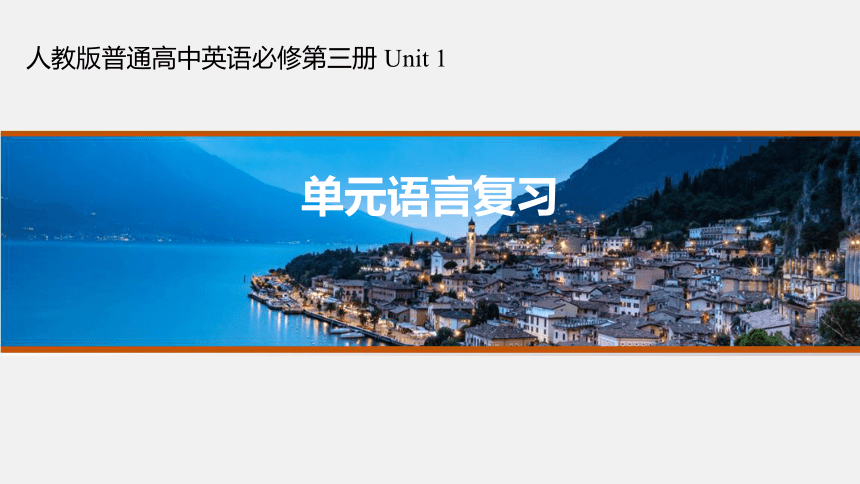 | |
| 格式 | pptx | ||
| 文件大小 | 3.2MB | ||
| 资源类型 | 教案 | ||
| 版本资源 | 人教版(2019) | ||
| 科目 | 英语 | ||
| 更新时间 | 2023-07-23 21:45:15 | ||
图片预览


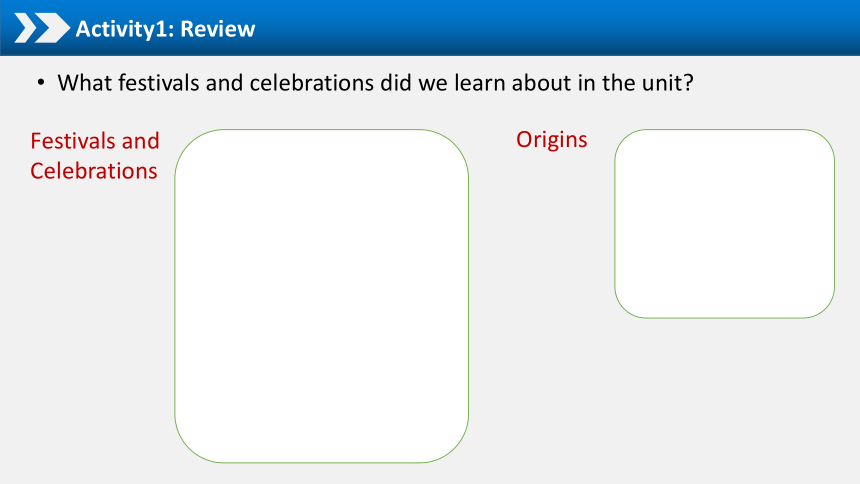
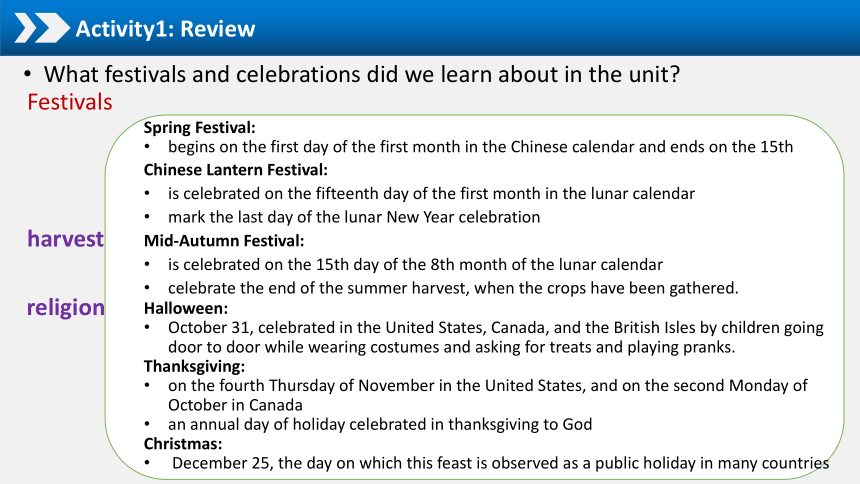
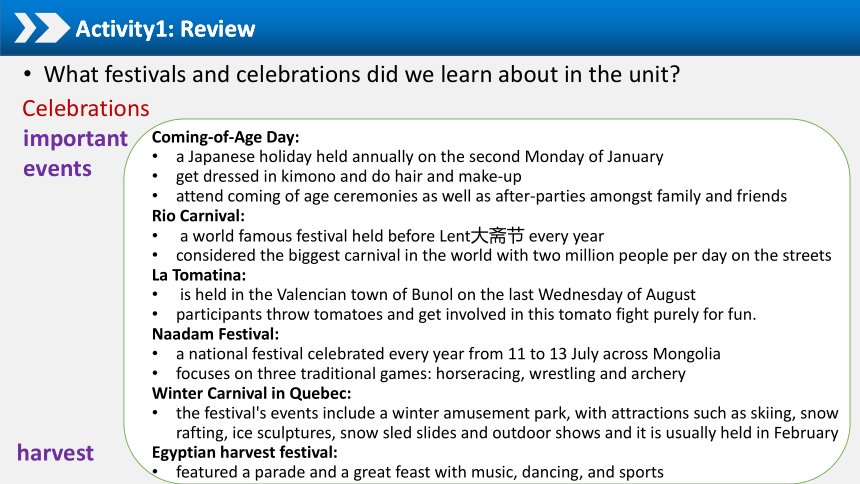

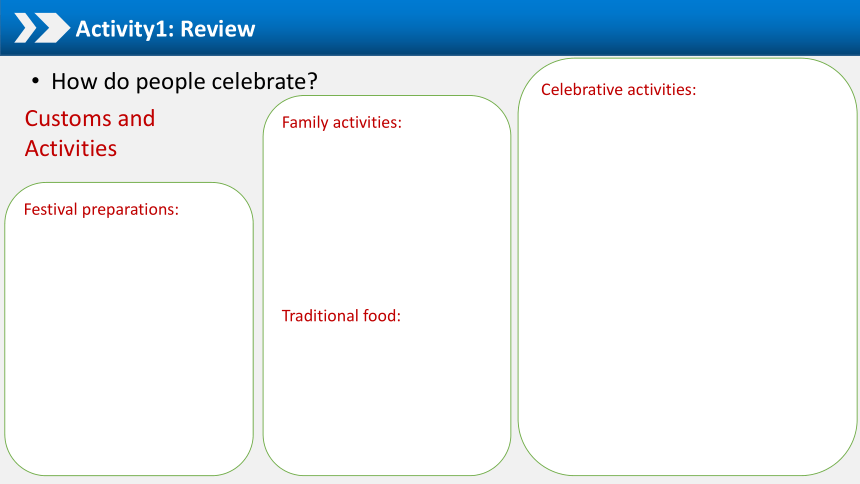
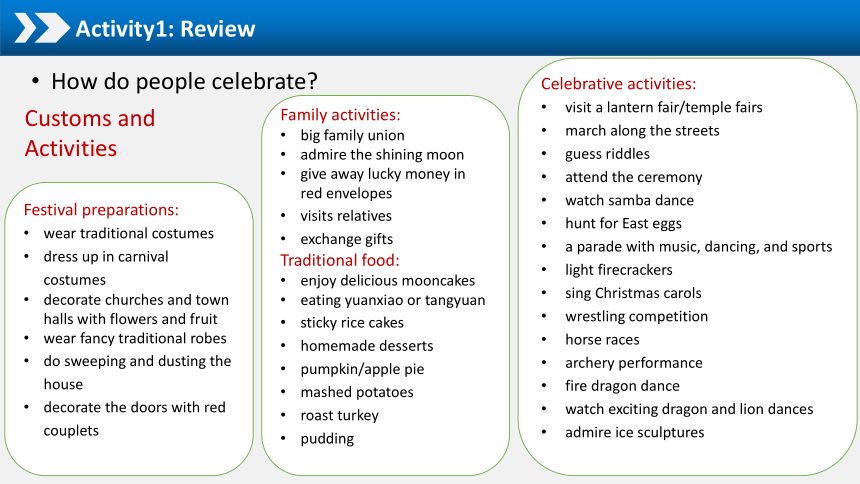
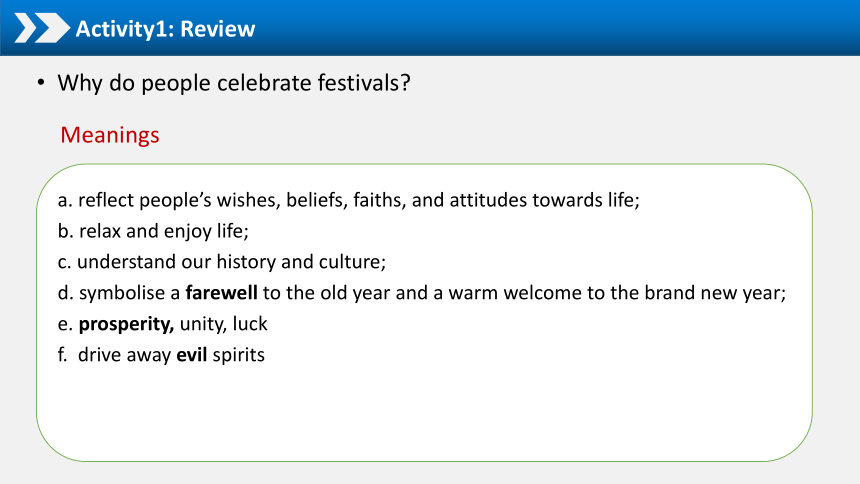
文档简介
(共21张PPT)
人教版普通高中英语必修第三册 Unit 1
单元语言复习
Period 1
Activity1: Review
What festivals and celebrations did we learn about in the unit
Festivals and Celebrations
Origins
Activity1: Review
What festivals and celebrations did we learn about in the unit
Festivals
Spring Festival:
begins on the first day of the first month in the Chinese calendar and ends on the 15th
Chinese Lantern Festival:
is celebrated on the fifteenth day of the first month in the lunar calendar
mark the last day of the lunar New Year celebration
Mid-Autumn Festival:
is celebrated on the 15th day of the 8th month of the lunar calendar
celebrate the end of the summer harvest, when the crops have been gathered.
Halloween:
October 31, celebrated in the United States, Canada, and the British Isles by children going door to door while wearing costumes and asking for treats and playing pranks.
Thanksgiving:
on the fourth Thursday of November in the United States, and on the second Monday of October in Canada
an annual day of holiday celebrated in thanksgiving to God
Christmas:
December 25, the day on which this feast is observed as a public holiday in many countries
religion
harvest
Activity1: Review
What festivals and celebrations did we learn about in the unit
Celebrations
Coming-of-Age Day:
a Japanese holiday held annually on the second Monday of January
get dressed in kimono and do hair and make-up
attend coming of age ceremonies as well as after-parties amongst family and friends
Rio Carnival:
a world famous festival held before Lent大斋节 every year
considered the biggest carnival in the world with two million people per day on the streets
La Tomatina:
is held in the Valencian town of Bunol on the last Wednesday of August
participants throw tomatoes and get involved in this tomato fight purely for fun.
Naadam Festival:
a national festival celebrated every year from 11 to 13 July across Mongolia
focuses on three traditional games: horseracing, wrestling and archery
Winter Carnival in Quebec:
the festival's events include a winter amusement park, with attractions such as skiing, snow rafting, ice sculptures, snow sled slides and outdoor shows and it is usually held in February
Egyptian harvest festival:
featured a parade and a great feast with music, dancing, and sports
Activity1: Review
important events
harvest
Activity1: Review
What festivals and celebrations did we learn about in the unit
Festivals and Celebrations
Coming-of-Age Day
Chinese Lantern Festival
Rio Carnival
Egyptian harvest festival
Mid-Autumn Festival
Spring Festival
Halloween
Thanksgiving
Christmas
La Tomatina
Naadam Festival
Winter Carnival in Quebec
Origins
a. religious;
b. harvest/agriculture;
c. famous figures;
d. important events;
Activity1: Review
How do people celebrate
Customs and
Activities
Festival preparations:
Family activities:
Traditional food:
Celebrative activities:
Activity1: Review
How do people celebrate
Festival preparations:
wear traditional costumes
dress up in carnival costumes
decorate churches and town halls with flowers and fruit
wear fancy traditional robes
do sweeping and dusting the house
decorate the doors with red couplets
Family activities:
big family union
admire the shining moon
give away lucky money in red envelopes
visits relatives
exchange gifts
Traditional food:
enjoy delicious mooncakes
eating yuanxiao or tangyuan
sticky rice cakes
homemade desserts
pumpkin/apple pie
mashed potatoes
roast turkey
pudding
Celebrative activities:
visit a lantern fair/temple fairs
march along the streets
guess riddles
attend the ceremony
watch samba dance
hunt for East eggs
a parade with music, dancing, and sports
light firecrackers
sing Christmas carols
wrestling competition
horse races
archery performance
fire dragon dance
watch exciting dragon and lion dances
admire ice sculptures
Customs and
Activities
Activity1: Review
Why do people celebrate festivals
Meanings
a. reflect people’s wishes, beliefs, faiths, and attitudes towards life;
b. relax and enjoy life;
c. understand our history and culture;
d. symbolise a farewell to the old year and a warm welcome to the brand new year;
e. prosperity, unity, luck
f. drive away evil spirits
Festivals and Celebrations in different countries
Festivals and Celebrations
The purposes and holiday spirits
The experiences and developments
basic information
origins
the purposes for celebrations
the holiday spirits
the preparations
family celebrations
traditional food
social customs
Activity1: Review
the Spring Festival
the Lantern Festival
the Dragon Boat Festival
Tomb-Sweeping Day
the Mid-autumn Festival
Activity2: Introduce Chinese festivals
What are the most important traditional festivals of China
Spring Festival is the most important of the traditional Chinese holidays which traditionally begins on the first day of the first month in the Chinese calendar and ends on the 15th.
Chinese New Year is the longest and most important festivity in the Lunar Calendar. The origin of Chinese New Year is itself centuries old and gains significance because of several myths and traditions. Ancient Chinese New Year is a reflection on how the people behaved and what they believed in the most.
Within China, regional customs and traditions concerning the celebration of the Chinese new year vary widely. People will pour out their money to buy presents, decoration, material, food, and clothing. It is also the tradition that every family thoroughly cleans the house to sweep away any ill-fortune in hopes to make way for good incoming luck. Windows and doors will be decorated with red colour paper-cuts and couplets with popular themes of “happiness”, “wealth”, and “longevity”. On the Eve of Chinese New Year, supper is a feast with families. Food will include such items as pigs, ducks, chicken and sweet delicacies. The family will end the night with firecrackers. Early the next morning, children will greet their parents by wishing them a healthy and happy new year, and receive money in red paper envelopes. The Chinese New Year tradition is a great way to reconcile forgetting all grudges, and sincerely wish peace and happiness for everyone.
Activity2: Introduce Chinese festivals
the Spring Festival
How to describe a festival
time
origin
customs
activities
Activity2: Introduce Chinese festivals
begins on the first day of the first month in the Chinese calendar and ends on the 15th
the longest and most important festivity in the Lunar Calendar
Ancient Chinese New Year is a reflection on how the people behaved and what they believed in the most.
Pour out their money to buy presents, decoration, material, food, and clothing.
Every family thoroughly cleans the house to sweep away any ill-fortune in hopes to make way for good incoming luck.
Windows and doors will be decorated with red colour paper-cuts and couplets with popular themes of “happiness”, “wealth”, and “longevity”.
On the Eve of Chinese New Year, supper is a feast with families.
Children will greet their parents by wishing them a healthy and happy new year, and receive money in red paper envelopes.
the Spring Festival
基本信息
节日起源
节日意义
节日精神
庆祝准备
家庭活动
传统食物
社会习俗
中国的节日和庆典
节日的意义与内涵
节日的体验和发展
the Spring Festival
the Lantern Festival
the Dragon Boat Festival
Tomb-Sweeping Day
the Mid-autumn Festival
Homework:Introduce another Chinese festivals
Period 2
Project
学校将进行主题为“Festivals and Celebrations”的校园文化展,现征集展示作品,需要海报设计加文本介绍,可从以下几方面选题:
介绍某一个中外的节日或庆典(如元宵节,圣诞节等)
聚焦某一与节日相关的话题(如节日起源,节日食物,庆典活动等)
中外节日文化的异同(如庆祝方式,节日意义等)
Mid-Autumn Festival
Halloween
On the traditional Christmas table, roast turkey is an indispensable dish. In some Asian countries, perhaps only this year Christmas genius eat turkey, to celebrate the festival; but in Europe, especially in America, a carnivorous Turkey is a very common, but also in the Thanksgiving and Christmas the two big day, Turkey is the traditional food.
This custom has been more than 300 years old. It is said that on Christmas day in 1620, a large number of immigrants from Britain arrived in the mountains of Mount Tai on the American continent. At that time, there was a shortage of food, only turkeys that spread all over the mountains, so they caught turkeys for the main course of the feast for the Christmas dinner, in addition to ham, sweet potatoes, vegetables, plum pudding, fruit cake, cocktail.
The story of Turkey at Christmas
Every country has its own most magnificent festival. Seeing from the whole concept, both Chinese and western people take these two festivals as the moment of happiness, gathering together, visiting relatives and friends, sending presents to each other and enjoying nice food.
Love is the eternal subject of human being. China and western countries also have their own festivals to show their affections. Seventh Evening of the Seventh Lunar Month is the festival of Chinese lovers while Valentine's Day is of western lovers. Westerners' festival activities during Valentine's Day are nearly the same with Chinese people during their lovers' day. They buy each other roses and chocolates and will definitely have dates to show passion.
Besides, some festivals are the special days for the families to gather together. Both Chinese people and western people have the concept of gathering the whole family members together, especially on some special days. The Mid-autumn Day in China and Thanksgiving in American are two days of this type. In this time, all the family members try their best to gather together and have a festival meal together. In China, when it is The Mid –autumn Day, the whole family will eat moon cakes and appreciate the bright and round moon together. If any family member is absent, there must be pity in everyone's mind. On Thanksgiving Day, the families in America will gather together eating in order to commemorate their ancestors' hard working.
Typical Similarities Between China and Western Festival Cultures
The importance of festival and festival cultures makes it necessary to compare Chinese festivals and festival cultures with western countries. Of course, these two groups will have some differences.
Chinese festivals attach much importance to collectivism and emphasize more on the forms. Western festivals such as Mother's Day, Father's Day, Valentine's Day are more humanitarian than Chinese festivals. The western festivals attach importance to individuals. Generally speaking, Chinese festivals emphasize more on the forms. All the Chinese family member often make festival activities together, that is to say, there is little chance to emphasize the importance of a single person. Chinese festivals have the obvious social pared with Chinese festivals, the western ones are more self-centered and romantic.
Nearly all the traditional Chinese festivals have the histories of more than one thousand years. Spring Festival, Dragon Boat festival and The Seventh Evening of the Seventh Lunar Month are all among these traditional festivals. So Chinese festivals are relatively older because of its five thousand years history and civilization.
Some Differences Between Chinese and Western Festival Cultures
人教版普通高中英语必修第三册 Unit 1
单元语言复习
Period 1
Activity1: Review
What festivals and celebrations did we learn about in the unit
Festivals and Celebrations
Origins
Activity1: Review
What festivals and celebrations did we learn about in the unit
Festivals
Spring Festival:
begins on the first day of the first month in the Chinese calendar and ends on the 15th
Chinese Lantern Festival:
is celebrated on the fifteenth day of the first month in the lunar calendar
mark the last day of the lunar New Year celebration
Mid-Autumn Festival:
is celebrated on the 15th day of the 8th month of the lunar calendar
celebrate the end of the summer harvest, when the crops have been gathered.
Halloween:
October 31, celebrated in the United States, Canada, and the British Isles by children going door to door while wearing costumes and asking for treats and playing pranks.
Thanksgiving:
on the fourth Thursday of November in the United States, and on the second Monday of October in Canada
an annual day of holiday celebrated in thanksgiving to God
Christmas:
December 25, the day on which this feast is observed as a public holiday in many countries
religion
harvest
Activity1: Review
What festivals and celebrations did we learn about in the unit
Celebrations
Coming-of-Age Day:
a Japanese holiday held annually on the second Monday of January
get dressed in kimono and do hair and make-up
attend coming of age ceremonies as well as after-parties amongst family and friends
Rio Carnival:
a world famous festival held before Lent大斋节 every year
considered the biggest carnival in the world with two million people per day on the streets
La Tomatina:
is held in the Valencian town of Bunol on the last Wednesday of August
participants throw tomatoes and get involved in this tomato fight purely for fun.
Naadam Festival:
a national festival celebrated every year from 11 to 13 July across Mongolia
focuses on three traditional games: horseracing, wrestling and archery
Winter Carnival in Quebec:
the festival's events include a winter amusement park, with attractions such as skiing, snow rafting, ice sculptures, snow sled slides and outdoor shows and it is usually held in February
Egyptian harvest festival:
featured a parade and a great feast with music, dancing, and sports
Activity1: Review
important events
harvest
Activity1: Review
What festivals and celebrations did we learn about in the unit
Festivals and Celebrations
Coming-of-Age Day
Chinese Lantern Festival
Rio Carnival
Egyptian harvest festival
Mid-Autumn Festival
Spring Festival
Halloween
Thanksgiving
Christmas
La Tomatina
Naadam Festival
Winter Carnival in Quebec
Origins
a. religious;
b. harvest/agriculture;
c. famous figures;
d. important events;
Activity1: Review
How do people celebrate
Customs and
Activities
Festival preparations:
Family activities:
Traditional food:
Celebrative activities:
Activity1: Review
How do people celebrate
Festival preparations:
wear traditional costumes
dress up in carnival costumes
decorate churches and town halls with flowers and fruit
wear fancy traditional robes
do sweeping and dusting the house
decorate the doors with red couplets
Family activities:
big family union
admire the shining moon
give away lucky money in red envelopes
visits relatives
exchange gifts
Traditional food:
enjoy delicious mooncakes
eating yuanxiao or tangyuan
sticky rice cakes
homemade desserts
pumpkin/apple pie
mashed potatoes
roast turkey
pudding
Celebrative activities:
visit a lantern fair/temple fairs
march along the streets
guess riddles
attend the ceremony
watch samba dance
hunt for East eggs
a parade with music, dancing, and sports
light firecrackers
sing Christmas carols
wrestling competition
horse races
archery performance
fire dragon dance
watch exciting dragon and lion dances
admire ice sculptures
Customs and
Activities
Activity1: Review
Why do people celebrate festivals
Meanings
a. reflect people’s wishes, beliefs, faiths, and attitudes towards life;
b. relax and enjoy life;
c. understand our history and culture;
d. symbolise a farewell to the old year and a warm welcome to the brand new year;
e. prosperity, unity, luck
f. drive away evil spirits
Festivals and Celebrations in different countries
Festivals and Celebrations
The purposes and holiday spirits
The experiences and developments
basic information
origins
the purposes for celebrations
the holiday spirits
the preparations
family celebrations
traditional food
social customs
Activity1: Review
the Spring Festival
the Lantern Festival
the Dragon Boat Festival
Tomb-Sweeping Day
the Mid-autumn Festival
Activity2: Introduce Chinese festivals
What are the most important traditional festivals of China
Spring Festival is the most important of the traditional Chinese holidays which traditionally begins on the first day of the first month in the Chinese calendar and ends on the 15th.
Chinese New Year is the longest and most important festivity in the Lunar Calendar. The origin of Chinese New Year is itself centuries old and gains significance because of several myths and traditions. Ancient Chinese New Year is a reflection on how the people behaved and what they believed in the most.
Within China, regional customs and traditions concerning the celebration of the Chinese new year vary widely. People will pour out their money to buy presents, decoration, material, food, and clothing. It is also the tradition that every family thoroughly cleans the house to sweep away any ill-fortune in hopes to make way for good incoming luck. Windows and doors will be decorated with red colour paper-cuts and couplets with popular themes of “happiness”, “wealth”, and “longevity”. On the Eve of Chinese New Year, supper is a feast with families. Food will include such items as pigs, ducks, chicken and sweet delicacies. The family will end the night with firecrackers. Early the next morning, children will greet their parents by wishing them a healthy and happy new year, and receive money in red paper envelopes. The Chinese New Year tradition is a great way to reconcile forgetting all grudges, and sincerely wish peace and happiness for everyone.
Activity2: Introduce Chinese festivals
the Spring Festival
How to describe a festival
time
origin
customs
activities
Activity2: Introduce Chinese festivals
begins on the first day of the first month in the Chinese calendar and ends on the 15th
the longest and most important festivity in the Lunar Calendar
Ancient Chinese New Year is a reflection on how the people behaved and what they believed in the most.
Pour out their money to buy presents, decoration, material, food, and clothing.
Every family thoroughly cleans the house to sweep away any ill-fortune in hopes to make way for good incoming luck.
Windows and doors will be decorated with red colour paper-cuts and couplets with popular themes of “happiness”, “wealth”, and “longevity”.
On the Eve of Chinese New Year, supper is a feast with families.
Children will greet their parents by wishing them a healthy and happy new year, and receive money in red paper envelopes.
the Spring Festival
基本信息
节日起源
节日意义
节日精神
庆祝准备
家庭活动
传统食物
社会习俗
中国的节日和庆典
节日的意义与内涵
节日的体验和发展
the Spring Festival
the Lantern Festival
the Dragon Boat Festival
Tomb-Sweeping Day
the Mid-autumn Festival
Homework:Introduce another Chinese festivals
Period 2
Project
学校将进行主题为“Festivals and Celebrations”的校园文化展,现征集展示作品,需要海报设计加文本介绍,可从以下几方面选题:
介绍某一个中外的节日或庆典(如元宵节,圣诞节等)
聚焦某一与节日相关的话题(如节日起源,节日食物,庆典活动等)
中外节日文化的异同(如庆祝方式,节日意义等)
Mid-Autumn Festival
Halloween
On the traditional Christmas table, roast turkey is an indispensable dish. In some Asian countries, perhaps only this year Christmas genius eat turkey, to celebrate the festival; but in Europe, especially in America, a carnivorous Turkey is a very common, but also in the Thanksgiving and Christmas the two big day, Turkey is the traditional food.
This custom has been more than 300 years old. It is said that on Christmas day in 1620, a large number of immigrants from Britain arrived in the mountains of Mount Tai on the American continent. At that time, there was a shortage of food, only turkeys that spread all over the mountains, so they caught turkeys for the main course of the feast for the Christmas dinner, in addition to ham, sweet potatoes, vegetables, plum pudding, fruit cake, cocktail.
The story of Turkey at Christmas
Every country has its own most magnificent festival. Seeing from the whole concept, both Chinese and western people take these two festivals as the moment of happiness, gathering together, visiting relatives and friends, sending presents to each other and enjoying nice food.
Love is the eternal subject of human being. China and western countries also have their own festivals to show their affections. Seventh Evening of the Seventh Lunar Month is the festival of Chinese lovers while Valentine's Day is of western lovers. Westerners' festival activities during Valentine's Day are nearly the same with Chinese people during their lovers' day. They buy each other roses and chocolates and will definitely have dates to show passion.
Besides, some festivals are the special days for the families to gather together. Both Chinese people and western people have the concept of gathering the whole family members together, especially on some special days. The Mid-autumn Day in China and Thanksgiving in American are two days of this type. In this time, all the family members try their best to gather together and have a festival meal together. In China, when it is The Mid –autumn Day, the whole family will eat moon cakes and appreciate the bright and round moon together. If any family member is absent, there must be pity in everyone's mind. On Thanksgiving Day, the families in America will gather together eating in order to commemorate their ancestors' hard working.
Typical Similarities Between China and Western Festival Cultures
The importance of festival and festival cultures makes it necessary to compare Chinese festivals and festival cultures with western countries. Of course, these two groups will have some differences.
Chinese festivals attach much importance to collectivism and emphasize more on the forms. Western festivals such as Mother's Day, Father's Day, Valentine's Day are more humanitarian than Chinese festivals. The western festivals attach importance to individuals. Generally speaking, Chinese festivals emphasize more on the forms. All the Chinese family member often make festival activities together, that is to say, there is little chance to emphasize the importance of a single person. Chinese festivals have the obvious social pared with Chinese festivals, the western ones are more self-centered and romantic.
Nearly all the traditional Chinese festivals have the histories of more than one thousand years. Spring Festival, Dragon Boat festival and The Seventh Evening of the Seventh Lunar Month are all among these traditional festivals. So Chinese festivals are relatively older because of its five thousand years history and civilization.
Some Differences Between Chinese and Western Festival Cultures
